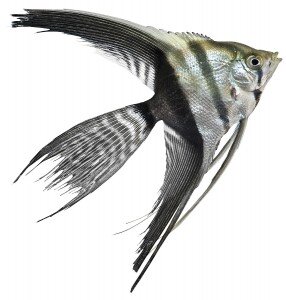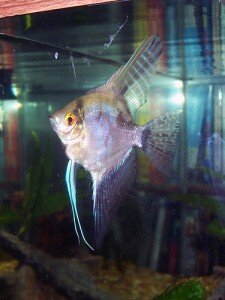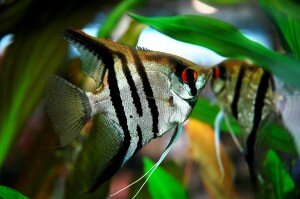There are dozens of freshwater angelfish varieties. All are the scalare angelfish species (Pterophyllum scalare) but have different color patterns and tail lengths. It’s important to note that many may not show their true coloring until they become adults. Something to keep in mind when selecting your young angelfish. Also, because producing unnatural colorings and patterns produces fish that would not survive in the wild and inbreeding may be involved in producing some of these varieties, some freshwater angelfish varieties are inherently less healthy than others. Often the more genetic mutations involved, the less healthy the fish may be.
Read What are Freshwater Angelfish Varieties? to read more about how angelfish varieties came to be.
Veil Angelfish
Veil angelfish may be the oldest known types of angelfish and are commonly found. In veils, the fins are significantly longer. This “makes them slower, a bit more sluggish, and more prone to diseases such as fin and tail rot” reports Ed Stansbury, the author of Breeding & Raising Angelfishes. They also need a much larger, taller tank to swim freely. This genetic mutation can be combined with most any color variation giving you an uniquely colored angelfish with long veil tails. Thus you will find marble veil, gold veil, and black veil angels for example. These are color varieties with the veil tail trait.
Marble Angelfish
This may be one of the most commonly found freshwater angelfish in fish stores. So common many would not recognize that this is a variety and not representative of a wild type angel. In the marble angel there’s a black marbling pattern over the whole body with a silver base. The fins have various patterns of black stripes. The top line of the fish is usually a orange to burnt orange color. No two marbles appear the same and are often crossed with other varieties such as silver or gold with stunning results. According to Breeding & Raising Angelfishes, “Marbled angels are genetically strong and show a high degree of resistance to common pathogens.”
Albino Angelfish
Albinos lack the black pigments. They have bright red eyes and almost white bodies with gold to yellow stripes. Their tails may appear to have a blue hue.
Gold Angelfish
A well named variety is the gold angelfish. They appear silver with gold hues. Younger golds look more silver and will gain the gold coloring by their first year.
Black Lace Angelfish
Black lace angelfish are mostly black with an undertone of silver giving a lacey appearance. The fins have some lace and some stripes depending on the individual fish.
Black Angelfish
Black angelfish are mostly black, sometimes appearing jet black, and come from parents that are both black lace. Although usually you sometimes can see the natural striping under the right light.
Ghost Angelfish
These are silver angels without stripes.
Smokey Angelfish
Smokey angelfish can be black and silver striped to marbled, but with a dull smokey appearance throughout.
Blushing Angelfish
These are a light golden transparent angel with bright orange to red gills, giving them a blushing appearance.
Chocolate Angelfish
Chocolate angelfish have two of the smokey gene mutations and have a more dark chocolate appearance throughout.
Clown Angelfish
The clown angelfish, first seen in the early 1980s, has a silver body with black splotches that differs from the marble pattern of the marble angelfish.
Zebra Angelfish
The zebra angel has extra stripes (the wild and silver angels have only three) and coloring can vary. The fins can have an interesting mix of spots and strips.
Gold Marble Angelfish
As adults these are gold to almost orange fish with some black marbling.
Leopard Angelfish
The leopard angelfish has spots rather than stripes. The spotted pattern needs just the right amount of light to fully develop into adulthood. If the lighting is not right, it make look like a smokey angelfish as an adult.
Koi Angelfish
Breeding the gold marble with a blushing angelfish gets you the koi variety. These are mottled fish that come in a variety of color patterns, resembling koi carp commonly kept in backyard ponds.
Pearlscale Angelfish
Also known as pearly or crystal, the pearlscale angelfish does look to have pearl colored crystal scales. It seems to shimmer as it swims through a lighted tank.
Half Black Angelfish
As the name suggests, half black angels are half black. They are silver on the front and black towards the back.
This list is not exhaustive as breeders try new pairings to create new color patterns and new types of angelfish. Also, there are a number of varieties that come from combining these basic varieties. For example, a black ghost angelfish comes from black lace and ghost parents. A zebra lace can have the extra stripe with lace patterns on the tail. It’s interesting to note that only 12 known genes produce the many varieties of scalare angelfish.






